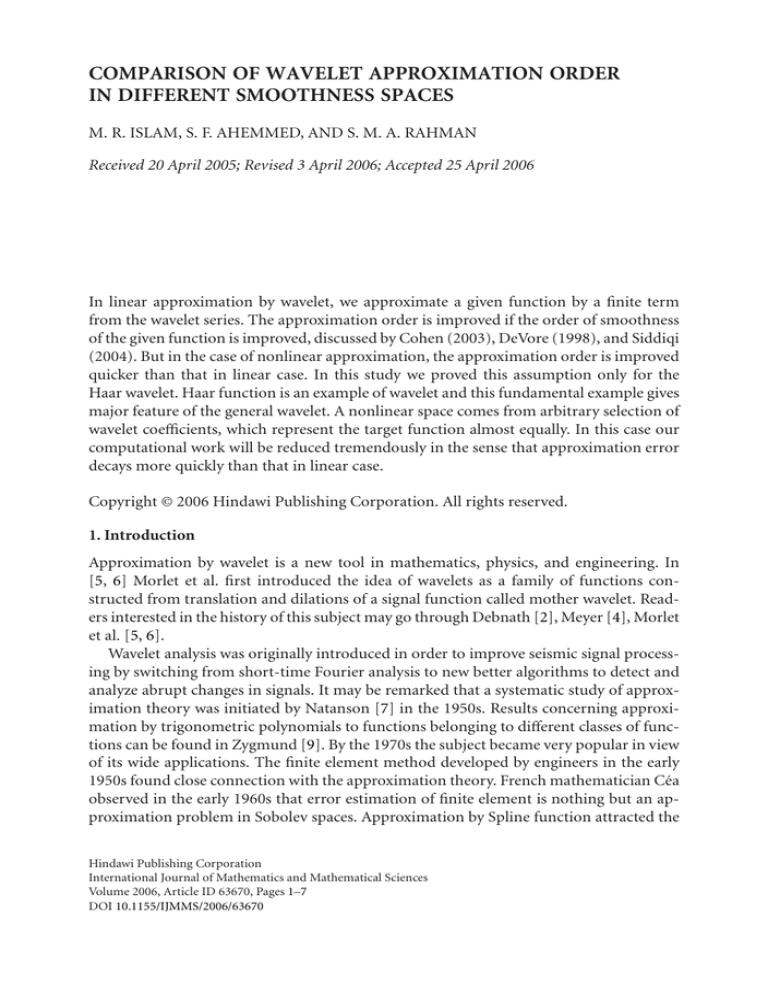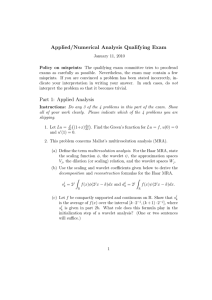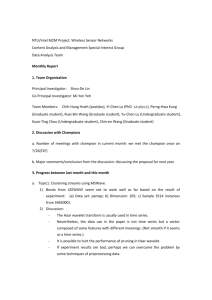
COMPARISON OF WAVELET APPROXIMATION ORDER
IN DIFFERENT SMOOTHNESS SPACES
M. R. ISLAM, S. F. AHEMMED, AND S. M. A. RAHMAN
Received 20 April 2005; Revised 3 April 2006; Accepted 25 April 2006
In linear approximation by wavelet, we approximate a given function by a finite term
from the wavelet series. The approximation order is improved if the order of smoothness
of the given function is improved, discussed by Cohen (2003), DeVore (1998), and Siddiqi
(2004). But in the case of nonlinear approximation, the approximation order is improved
quicker than that in linear case. In this study we proved this assumption only for the
Haar wavelet. Haar function is an example of wavelet and this fundamental example gives
major feature of the general wavelet. A nonlinear space comes from arbitrary selection of
wavelet coefficients, which represent the target function almost equally. In this case our
computational work will be reduced tremendously in the sense that approximation error
decays more quickly than that in linear case.
Copyright © 2006 Hindawi Publishing Corporation. All rights reserved.
1. Introduction
Approximation by wavelet is a new tool in mathematics, physics, and engineering. In
[5, 6] Morlet et al. first introduced the idea of wavelets as a family of functions constructed from translation and dilations of a signal function called mother wavelet. Readers interested in the history of this subject may go through Debnath [2], Meyer [4], Morlet
et al. [5, 6].
Wavelet analysis was originally introduced in order to improve seismic signal processing by switching from short-time Fourier analysis to new better algorithms to detect and
analyze abrupt changes in signals. It may be remarked that a systematic study of approximation theory was initiated by Natanson [7] in the 1950s. Results concerning approximation by trigonometric polynomials to functions belonging to different classes of functions can be found in Zygmund [9]. By the 1970s the subject became very popular in view
of its wide applications. The finite element method developed by engineers in the early
1950s found close connection with the approximation theory. French mathematician Céa
observed in the early 1960s that error estimation of finite element is nothing but an approximation problem in Sobolev spaces. Approximation by Spline function attracted the
Hindawi Publishing Corporation
International Journal of Mathematics and Mathematical Sciences
Volume 2006, Article ID 63670, Pages 1–7
DOI 10.1155/IJMMS/2006/63670
2
Comparison of wavelet approximation order
attention of several eminent mathematicians during the 1970s and 1980s. They are not
only convenient and suitable for computer calculations, but also provide optimal theoretical solution to the estimation of functions from limited data.
From the viewpoint of approximation theory and harmonic analysis, the wavelet theory is important on several counts. It gives simple and elegant unconditional wavelet
bases for function spaces (Lebesgue, Sobolev, Besov, etc.).
A recent development of approximation theory is approximation of an arbitrary function by wavelet polynomials. There are different types of wavelet such as Haar wavelet,
Mexican-Hat wavelet, Shannon wavelet, Daubechies wavelet, Meyer’s wavelet, and so
forth. In this paper we mainly focus on approximation by Haar wavelet. Haar function is
an example of wavelet and this fundamental example gives major feature of the general
wavelet.
Infinite series is a mathematical tool for exact representation of certain functions.
When we work with the series representations in practice, we are only able to deal with
finite sums. For example, if a function f has an exact representation through Fourier series, we need to have finite partial sum (SN )N ∈N for computer work. We need to choose N
such that the partial sum SN approximates f sufficiently well. For a good approximation
N becomes very large. If we can replace the partial sum SN by another finite sum, which
approximates f equally well by using fewer coefficients. This is the idea behind nonlinear
approximation.
In wavelet theory, if we approximate the target function by selecting terms of the
wavelet series, for which the target function f is kept controlled only over the number of
terms to be used, it is called N-term approximation. Our aim is to approximate a function
via Haar wavelet. In Section 2 we give a brief discussion on Haar wavelet and its properties. In Section 3 we approximate a function by Haar wavelet in different smoothness
spaces. Finally in Section 4 we use only few Haar coefficients for which it is nonlinear. In
that case we get a significant improvement of approximation order in comparison to any
other wavelet methods.
2. Haar wavelet systems
Definition 2.1 (Haar function). A function defined on the real line R as
⎧
⎪
⎪
⎪
1
⎪
⎪
⎪
⎪
⎨
ψ(t) = ⎪
−1
⎪
⎪
⎪
⎪
⎪
⎪
⎩
0
for t ∈ 0,
1
,
2
1
,1 ,
2
otherwise,
for t ∈
(2.1)
is known as Haar function.
The Haar function Ψ(t) is the simplest example of Haar wavelet. The Haar function
Ψ(t) is a wavelet because it satisfies all the conditions of wavelet. Haar wavelet is discontinuous at t = 0,1/2,1 and it is very well localized in the time domain.
M. R. Islam et al. 3
Definition 2.2 (dyadic interval). For each pair of j,k ∈ Z, define the interval I j,k by I j,k =
[2− j k,2− j (k + 1)] which is known as dyadic interval. The collection of all such intervals
is called dyadic subintervals of R.
Definition 2.3 (Haar scaling function). The family of functions {ϕi,k (t)}i,k∈Z = 2 j/2 ϕ(2 j t −
k) is called the system of Haar scaling functions. For each j, k ∈ Z, the collection of
{ϕi,k (t)}i,k∈Z is called the Haar scaling function at scale j.
Haar scaling function can be defined as
⎧
⎪
⎨1
if 0 ≤ t < 1,
ϕ(t) = χ[0,1) (t) = ⎪
⎩0
(2.2)
otherwise.
For each j,k ∈ Z, {ϕi,k (t)}i,k∈Z = 2 j/2 ϕ(2 j t − k) = D2 j Tk ϕ(t), where dilation operator
Da f (x) = a1/2 f (ax) and the translation of operator Tk f (x) = f (x − k).
Definition 2.4 (Haar wavelet system). For each j,k ∈ Z, define {ψi,k (t)}i,k∈Z = 2 j/2 ψ(2 j t −
k). The family of functions {ψi,k (t)}i,k∈Z is called the Haar wavelet system.
Consider f (t) is defined on L2 [0,1], has an expansion in terms of Haar functions as
follows. For any integer J ≥ 0,
f (t) =
j −1
2
=
k =0
f ,ψ j,k ψJ,k (t)
j =J k =0
k =0
j −1
2
∞ 2
−1
j
f ,ϕJ,k ϕJ,k (t) +
∞ 2
−1
(2.3)
j
cJ,k ϕJ,k (t) +
d j,k ψJ,k (t)
j =J k =0
which is known as Haar series; and d j,k and c j,k are the Haar coefficients for wavelet and
Haar scaling coefficients, respectively.
3. Approximation by Haar wavelet in different spaces
3.1. Approximation space. Let (X, · X ) be a normed space in which the approximation takes place. Let (SN )N ≥0 be a family of subspaces of a normed space X. Our approximation comes from the space (SN )N ≥0 ⊂ X.
For a function f ∈ X, the approximation error is EN ( f )X = dist ·( f ,SN )X = inf g ∈SN
f − g X , where g is the approximating function in (SN )N ≥0 .
For linear approximation. N represents the number of parameters, which are needed to
describe an element in SN . That is, N is dimension of SN . In most cases of interest EN ( f )
goes to zero as N tends to infinity.
For nonlinear approximation. N is related to the number of free parameters. For example,
N might be the number of knots in piecewise constant approximation with free knots.
The SN can be quite general spaces; in particular, they do not have to be linear.
4
Comparison of wavelet approximation order
3.2. Approximation in L2 (R). Let f be continuous on L2 (R) and the Haar wavelet se 2 j −1
ries of f is f ≈ ∞
j =0 k=0 f ,ψ j,k ψ j,k (t). If ψ j,k (t) is support on the interval I j,k =
[2− j k,2− j (k + 1)], then
f ,ψ j,k =
R
f (t)ψ j,k (t)dt = 2
− j/2
(k+1)2− j
k2− j
f (t)ψ 2 j t − k dt.
(3.1)
For computing finite sum, let N = 2J be coefficients for some J ∈ N.
j
That is, we consider j = 0,1,2,3,...,J − 1, then Jj−=10 n2 =−01 1 = 1 + 2 + 22 + · · · + 2J −
1 = N − 1 coefficients. For Haar wavelet we can see that for each j only one of the coefficients is nonzero and its size is 2− j/2 . For details one can see Christensen and Christensen
[1] and Walnut [8].
Then the error of the approximation in L2 (R) is
∞ 2 j −1
2
2
j −1
j −1
J
−1 2
∞ 2
f ,ψ j,k 2
f −
f ,ψ j,k ψ j,k (t)
=
f ,ψ j,k ψ j,k (t)
=
j =0 k =0
j =J k=0
L2
≈
∞
L2
2 − j ≈ 2 −J ≈
j =J
j =J k=0
1
= O 2 −J .
N
(3.2)
3.3. Approximation in L p (R).
Theorem 3.1. If f ∈ L p (R) and the partial sum of the Haar wavelet series of f is g =
J −1 2 j −1
−J/2
).
j =0
k=0 f ,ψ j,k ψ j,k (t), for j ∈ N, then the error of the approximation is O(2
Proof. The error of the approximation in L p (R) is
f − g L p
j −1
J
−1 2
=f −
f
,ψ
ψ
(t)
j,k
j,k
j =0 k=0
≈
∞ 2
−1
f ,ψ j,k p
j
1/ p
j =J k =0
Lp
≈
∞ 2 j −1
=
f
,ψ
ψ
(t)
j,k
j,k
∞
j =J k =0
1/ p
2− j p/2
Lp
(3.3)
≈ 2−J/2 = O 2−J/2 ).
j =J
3.4. Approximation in LipM (α,L p ) spaces.
Theorem 3.2. If f ∈ LipM (α,L p ), 0 < α ≤ 1, 1 < p ≤ ∞, M > 0, and g(t) = Jj−=10 2k=−01 f ,
ψ j,k ψ j,k (t) is the Haar wavelet series of f for some J ∈ N, then the error of the approximation in LipM (α,L p ) is O(2−Jα ).
j
Proof. From DeVore [3] we have if f ∈ LipM (α,L p ), 0 < α ≤ 1, 1 < p ≤ ∞, dist( f ,SN ) p ≤
inf g ∈SN f − g p ≤ C p | f |Lip(α,L p ) δ α , where δ = max0≤k<N |tk+1 − tk |.
M. R. Islam et al. 5
So the error of the approximation in LipM (α,L p ) is
f − g L p
j −1
J
−1 2
=f −
f
,ψ
ψ
(t)
j,k
j,k
j =0 k =0
Lp
α
≤ C p | f |Lip(α,L p ) 2−J
(3.4)
α
≤ M 2−J = O 2−Jα ,
where C p is depending on p.
3.5. Approximation in Sobolev spaces H m (R).
Theorem 3.3. If f ∈ H m (R) and g(t) = Jj−=10 Nk=0 f ,ψ j,k ψ j,k (t) is the finite Haar
wavelet series of f for some J ∈ N, then the error of the approximation is O(2−mN/2 ), where
N = 2J .
Proof. The error of the approximation is
f − g L 2
∞ N −1
=
f ,ψ j,k ψ j,k (t)
j =J k=0
≤
∞ 2
−1
f ,ψ j,k 2
j
L2
1/2
≤
j =J k=0
≤ 2
−mN
∞ N
−1 mk
2 f ,ψ j,k 2
j =J k =0
∞ N
−1
2
mk 2
f ,ψ j,k 1/2
(3.5)
2mN
1/2 .
j =J k=0
By using the properties of Besov space we have
f
H m (L
∼
2 (R)) =
∞ N
−1
2
mk 2
f ,ψ j,k 1/2 .
(3.6)
j =J k =0
Therefore f − g L2 ≤ 2−mN/2 f H m (L2 (R)) = O(2−mN/2 ).
3.6. Approximation in Besov space Bqα (L p (R)).
Theorem 3.4. If f ∈ Bqα (Lq (R)), α > 0, 0 < q ≤ ∞, and g(t) = Jj−=10 Nk=0 f ,ψ j,k ψ j,k (t)
is the finite Haar wavelet series of f for some J ∈ N, then the error of the approximation is
O(2−αN/2 ), where N = 2J .
6
Comparison of wavelet approximation order
Proof. The error of the approximation is
f − g L q
∞ N −1
=
f
,ψ
ψ
(t)
j,k
j,k
j =J k=0
≤
∞ N
−1
f ,ψ j,k q
Lq
1/q
≤
j =J k=0
≤ 2−αv/q
∞ N
−1 αk
2 f ,ψ j,k q
j =J k=0
∞ N
−1
q
2αk f ,ψ j,k 1/q
2αN
(3.7)
1/q .
j =J k=0
By using the properties of Besov space we have
f Bqm (Lq (R)) ∼
=
∞ N
−1
2
αk q
f ,ψ j,k 1/q .
(3.8)
j =J k =0
Therefore f − g Lq(R) ≤ 2−αN/q f Bqα (Lq (R)) = O(2−αN/q ), where 1/q = α/2 + 1/2.
Conclusion. The above theorem shows that the approximation order will improve if the
smoothness of the approximation spaces is improved.
4. Nonlinear approximation by Haar wavelet
Our previous discussion is finite linear approximation by Haar wavelet. Now we consider
nonlinear approximation via Haar wavelet. We have seen that for each level j, exactly one
Haar coefficient is nonzero. One can see Christensen and Christensen [1] and Walnut [8].
If we can calculate N = 2J biggest Haar coefficients, in that case the approximation
error is
σN ( f )X = dist · f ,SN
X
= inf
f − g X ,
g∈
(4.1)
N
where ΣN and σN ( f ) denote the set of wavelets and approximation error, respectively, in
the nonlinear spaces.
4.1. Nonlinear approximation in L p (R).
Theorem 4.1. If f ∈ L p (R) and the partial sum of the Haar wavelet series of f is g =
N −1 N −1
j =0
k=0 f ,ψ j,k ψ j,k (t), for j ∈ N, then the error of the nonlinear approximation is
O(2−N/ p ).
M. R. Islam et al. 7
Proof. The error of the nonlinear approximation in L p (R) is
f − g L p
N
−1 N
−1
=f −
f
,ψ
ψ
(t)
j,k
j,k
j =0 k=0
≤
∞
−1
N
j =N+1 k=0
f ,ψ j,k p
Lp
∞ N −1
=
f
,ψ
ψ
(t)
j,k
j,k
1/ p
≈
j =N+1 k=0
∞
1/ p
2−N p/2
Lp
≈ 2−N/2 = O 2−N/2 .
j =N+1
(4.2)
Conclusion. From the above discussion we have seen that in the case of linear approximation the approximation order depends on the order of smoothness of the function
space. But in the case of nonlinear approximation there is a significant improvement in
the approximation order compared to that in linear approximation.
References
[1] O. Christensen and K. L. Christensen, Approximation theory. From Taylor Polynomials to
Wavelets, Applied and Numerical Harmonic Analysis, Birkhäuser Boston, Massachusetts, 2004.
[2] L. Debnath, Wavelet Transforms and Their Applications, Birkhäuser Boston, Massachusetts,
2002.
[3] R. A. DeVore, Nonlinear approximation, Acta Numerica, vol. 7, Cambridge University Press,
Cambridge, 1998, pp. 51–150.
[4] Y. Meyer, Wavelets: their past and their future, Progress in Wavelet Analysis and Applications
(Toulouse, 1992) (Y. Meyer and S. Roques, eds.), Frontières, Gif-sur-Yvette, 1993, pp. 9–18.
[5] J. Morlet, G. Arens, E. Fourgeau, and D. Giard, Wave propagation and sampling theory, part I:
complex signal land scattering in multilayer media, Geophysics 47 (1982), no. 2, 203–221.
, Wave propagation and sampling theory, part II: sampling theory complex waves, Geo[6]
physics 47 (1982), no. 2, 222–236.
[7] I. P. Natanson, Constructive Function Theory, Gosudarstvennoe Izdatel’stvo Tehniko-Teoretičeskoı̆ Literatury, Moscow, 1949.
[8] D. F. Walnut, An Introduction to Wavelet Analysis, Applied and Numerical Harmonic Analysis,
Birkhäuser Boston, Massachusetts, 2002.
[9] A. Zygmund, Trigonometric Series. Vols. I, II, 2nd ed., Cambridge University Press, New York,
1959.
M. R. Islam: Mathematics Discipline, Khulna University, Khulna 9208, Bangladesh
E-mail address: mrislam66@gmail.com
S. F. Ahemmed: Mathematics Discipline, Khulna University, Khulna 9208, Bangladesh
E-mail address: sfahemmed@yahoo.com
S. M. A. Rahman: Mathematics Discipline, Khulna University, Khulna 9208, Bangladesh
E-mail address: arahmanku@yahoo.com







